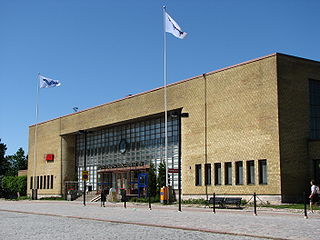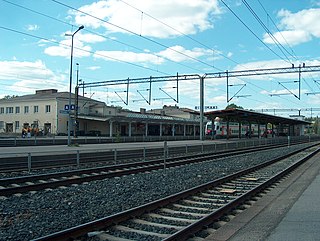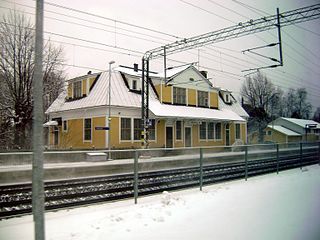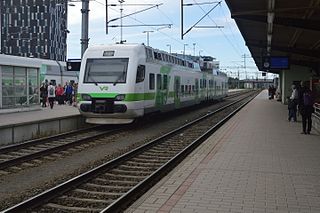
The transport system of Finland is well-developed. Factors affecting traffic include the sparse population and long distance between towns and cities, and the cold climate with waterways freezing and land covered in snow for winter.

Helsinki-Vantaa Airport, or simply Helsinki Airport, is the main international airport serving Helsinki, the capital of Finland, as well as its surrounding metropolitan area, and the Uusimaa region in Finland. The airport is located in the neighbouring city of Vantaa, about 5 kilometres (3 mi) west of Tikkurila, the administrative centre of Vantaa and 9.2 NM north of Helsinki's city centre. The airport is operated by state-owned Finavia. The facility covers a total of 1,800 hectares of land and contains three runways.

Helsinki commuter rail is a commuter rail system serving the Helsinki metropolitan area. The system is managed by the Helsinki Regional Transport Authority (HSL) and operations are contracted out to VR at least until 2031.

The Ring Rail Line is a railway route in the area of the city of Vantaa, in the Greater Helsinki Metropolitan Area of Finland. It connects Helsinki-Vantaa Airport and the adjacent Aviapolis business and retail district to the Helsinki commuter rail network. The line fills the gap between Vantaankoski and Tikkurila railway stations, travelling in tunnel underneath the airport.

The Finnish railway network consists of a total track length of 9,216 km (5,727 mi). The railways are built with a broad 1,524 mm track gauge, of which 3,249 km (2,019 mi) is electrified. Passenger trains are operated by the state-owned enterprise VR that runs services on 7,225 km (4,489 mi) of track. These services cover all major cities and many rural areas, though the coverage is less than the coverage provided by the bus services. Most passenger train services originate or terminate at Helsinki Central railway station, and a large proportion of the passenger rail network radiates out of Helsinki. VR also operates freight services. Maintenance and construction of the railway network itself is the responsibility of the Finnish Rail Administration, which is a part of the Finnish Transport Agency. The network consists of six areal centres, that manage the use and maintenance of the routes in co-operation. Cargo yards and large stations may have their own signalling systems.

Turku Central Station is a railway station in the VII District of Turku, Finland. It has VR services to Helsinki and towards Joensuu. The station serves approximately a million passengers annually.

Public transport in Helsinki consists of bus, tram, metro, local railway and ferry services. The system is managed by the Helsinki Regional Transport Authority and covers Helsinki, Espoo, Kauniainen, Vantaa and the outlying Kerava, Kirkkonummi, Sipoo and Tuusula.

Riihimäki railway station is a railway station located in the town of Riihimäki, Finland.

Although Finland has no dedicated high-speed rail lines, sections of its rail network are capable of running speeds of up to 220 km/h (137 mph). The Finnish national railway company VR operates tilting Alstom Pendolino trains. The trains reach their maximum speed of 220 km/h (137 mph) in regular operation on a 75.7 km (47.0 mi) route between Kerava and Lahti. This portion of track was opened in 2006. The trains can run at 200 km/h (124 mph) on a longer route between Helsinki and Seinäjoki and peak at that speed between Helsinki and Turku. The main railway line between Helsinki and Oulu has been upgraded between Seinäjoki and Oulu to allow for trains to run at speeds between 160 km/h (99 mph) and 200 km/h (124 mph). Other parts of the Finnish railway network are limited to lower speed.

The Helsinki–Tallinn Tunnel is a proposed undersea tunnel that would span the Gulf of Finland and connect the Finnish and Estonian capitals by train. The tunnel's length would depend upon the route taken: the shortest distance across would have a submarine length of 80 kilometres (50 mi), which would make it 40% longer than the current longest railway tunnel in the world, the 57 km Gotthard Base Tunnel. It has been estimated that the tunnel, if constructed, will cost €9–13 billion. It may open in the 2030s. The European Union has approved €3.1 million in funding for feasibility studies. A pre-feasibility study from 2015 proposed a 250 km/h top speed.

The Helsinki City Rail Loop is a planned new railway line in Helsinki, Southern Finland. It is to be a double track balloon loop in the shape of a tear drop. Helsinki commuter rail currently terminating at Helsinki Central railway station would be diverted into tunnels under the city centre. New underground stations would be created in Töölö (west), Helsinki city centre and Hakaniemi metro station (east), with a possible fourth station at Alppila (north) depending on how the connection to the main line is made in relation to the existing northern Pasila railway station. The new tracks will be 7 kilometres (4 mi) long.

Helsinki Airport station is a Helsinki commuter rail station located at Helsinki Airport in Vantaa, Finland.

Helsinki–Riihimäki railway is a railway running between the Helsinki Central railway station and the Riihimäki railway station in Finland, and it is part of the Finnish Main Line. It was opened in 1862 as a part of the Finland's first railway between Helsinki and Hämeenlinna. The Helsinki commuter rail system also runs by the Helsinki–Riihimäki railway.

Riihimäki–Tampere railway is a railway running between the Riihimäki railway station and the Tampere railway station in Finland, and it is part of the Finnish Main Line. The line between Riihimäki and Hämeenlinna was opened in 1862 as a part of the Finland's first railway between Helsinki and Hämeenlinna, and the line between Riihimäki and Tampere in 1876.

The Kerava–Lahti railway line or Lahden oikorata is a railway line in southern Finland between the towns of Kerava and Lahti, which opened on 3 September 2006.
Itärata is a proposed railway line in the planning stage to provide a more direct connection between Helsinki and Kouvola, Finland than the current route via Kerava and Lahti.

The Turenki railway station is located in the municipality of Janakkala, Finland, in the urban area and municipal seat of Turenki. It is located along the Riihimäki–Tampere railway, and its neighboring stations are Hämeenlinna in the north and Ryttylä in the south.

The Parola railway station is located in the municipality of Hattula, Finland, in the urban area and municipal seat of Parola. It is located along the Riihimäki–Tampere railway, and its neighboring stations are Iittala in the north and Hämeenlinna in the south.

The Helsinki–Turku high-speed railway or Espoo–Salo-oikorata, also formerly known as the ELSA-rata (Espoo-Lohja-Salo), is a proposed railway line in the planning stage to provide a more direct connection between Helsinki and Turku, Finland than the current Rantarata railway line which follows the southern coast. The project is also known as Turun tunnin juna, despite the fact that a journey between Helsinki and Turku on the new line would last about one hour and 18 minutes.

VR commuter rail is a Finnish commuter rail system operated by VR – the national railway operator of Finland – under a public service obligation agreement with the Ministry of Transport and Communications of Finland. The operations are planned in trilateral co-operation between the ministry, the operator and various regional transport authorities.


















